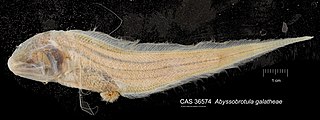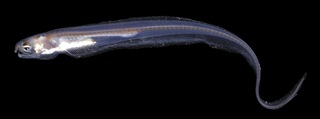Ophidiiformes is an order of ray-finned fish that includes the cusk-eels, pearlfishes, viviparous brotulas, and others. Members of this order have small heads and long slender bodies. They have either smooth scales or no scales, a long dorsal fin and an anal fin that typically runs into the caudal fin. They mostly come from the tropics and subtropics, and live in both freshwater and marine habitats, including abyssal depths. They have adopted a range of feeding methods and lifestyles, including parasitism. The majority are egg-laying, but some are viviparous.

The cusk-eel family, Ophidiidae, is a group of marine bony fishes in the Ophidiiformes order. The scientific name is from the Greek ophis meaning "snake", and refers to their eel-like appearance. True eels diverged from other ray-finned fish during the Jurassic, while cusk-eels are part of the Percomorpha clade, along with tuna, perch, seahorses and others.

Abyssobrotula galatheae is a species of cusk eel in the family Ophidiidae. It is the deepest-living fish known; one specimen, trawled from a depth of 8,370 m (27,460 ft) in the Puerto Rico Trench in 1970, holds the record for the deepest fish ever captured. Although generally recognized, some have suggested that the record-breaking individual might have been caught with a non-closing net and therefore perhaps caught shallower.
Onuxodon is an Indo-Pacific genus of pearlfishes from the family Carapidae. The generic name is derived from the Greek onyx meaning "claw" and odon meaning "tooth", referring to the sharp fang like teeth of Onuxodon parvibrachium. Species in this genus are distributed from South Africa to Hawaii. They live commensally with molluscs. The three currently recognized species are:
Bassogigas gillii is a species of cusk-eel found in the Indian, Pacific Ocean, and Atlantic Oceans at depths of from 637 to 2,239 metres.

Otophidium is a genus of cusk-eels, part of the subfamily Ophidiinae in the family Ophidiidae. They are found in the western Atlantic and eastern Pacific.
Parophidion is a genus of cusk-eels found in the Atlantic Ocean and the Mediterranean Sea.

Sirembo is a genus of cusk-eels of the subfamily Neobythitinae, family Ophidiidae, which are found in the Indian and Pacific Oceans. The species in this genus have a rather robust body with the dorsal fin originating over vertebrae 1–5. The head and bod are completely covered in scales, they have large eyes which are almost equal in diameter to the length of snout, the pelvic fins have two rays which are joined together within an area of tough skin, They have a short spine on the operculum which does not extend to the posterior edge of the head. Their coloration is variable but almost all species have black spots or eyespots on the dorsal fin, sometimes both, while the middle part of the anal fin frequently has a black band. The body and/or head are marked with diagonal or horizontal dark stripes or horizontal rows of quite large dusky spots.
The faceless cusk is a genus of cusk-eel found in the Indian and Pacific Oceans at depths from 3,935 to 5,100 m. This species grows to 46.5 cm (18.3 in) in standard length.

The band cusk-eel is a fish species in the family Ophidiidae. Widespread in the Western Atlantic from North Carolina, United States, and northern Gulf of Mexico to southeastern Brazil. Absent from The Bahamas. Marine reef-associated tropical demersal fish, up to 30 cm (12 in) long.
The basketweave cusk-eel is a fish species in the family Ophidiidae. It is widespread in the eastern Pacific Ocean from Point Arguello in California, United States, to Baja California. The basketweave cusk-eel is a marine subtropical demersal fish that can be up to 28 centimetres (11 in) long. The specific name honors the journalist and philanthropist Ellen Browning Scripps (1836-1932) one of the founders of the Scripps Research Institute.

Brotula barbata, commonly known as the goatsbeard brotula, is a species of cusk-eel in the genus Brotula. It lives in the Indo-Pacific, in depths of up to 300 meters. It is dark brown with a submarginal black band and narrow white border on the dorsal and anal fins versus greenish to orange brown with orange-bordered dorsal and anal fins, and it grows up to be around 100 centimeters. It has a carnivorous diet, and it is oviparous.

Brosmophycinae is a subfamily of the viviparous brotulas. They are divided from the subfamily Bythitinae by having the dorsal fin, caudal fin and anal fin all separate whereas they are joined in the Bythitinae. It is divided into the tribes Dinematichthyini and Brosmophycini, with the first having hardened genital claspers and the second soft genital claspers. A review in 2016 elevated the Dinematichthyini to the status of a family the Dinematichthyidae.

Brosmophycini is a tribe of viviparous brotula, one of two tribes in the subfamily Brosmophycinae. They are distinguished from the other brosmophycin tribe, the Dinematichthyini, by having a male intromittent organ which has no ossified parts, a scale-covered body and well developed gill rakers.

Bythitinae is a subfamily of viviparous brotulas, one of the two subfamilies in the family Bythitidae. This subfamily is characterised by having the dorsal, caudal and anal fins combined. They are mostly found in temperate to tropical seas, from reefs to the benthopelagic zone, but some species from the North Atlantic Ocean occur in into Arctic waters.
Bythitoidei is a suborder of the order Ophidiiformes, the cusk eels. They are distinguished from the other Ophidiform suborder, the Ophidioidei, by being largely viviparous.

Ophidiinae is a subfamily of the cusk eel family Ophidiidae. The species in the subfamily are characterised by having their pelvic fins situated far forward on the body and supported by a forward orientated extension of the pelvic girdle, they lack barbels on the mouth and chin and they are covered in small cycloid scales arranged in horizontal or diagonal rows. Some species have a modified swim bladder and the anterior vertebrae which enables them to generate sounds. and some of these modifications are sexually dimorphic and make the fish capable of generating sound. They have two rays in each ventral fin and the caudal fin has 9 rays. Most species are benthic and occur on the continental shelf.

Onuxodon fowleri is a species of pearlfish first described by Smith, 1955. Onuxodon fowleri is part of the genus Onuxodon and the subfamily Carapinae. No subspecies are listed in the Catalog of Life.

Lamprogrammus shcherbachevi, the scaleline cusk, is a species of marine ray-finned fish in the family Ophidiidae.
The Pacific bearded brotula also known as the pink bearded cusk-eel or the red bearded cusk-eel is a species of cusk eel found in the Pacific Ocean. It is described as being reddish-brown with dark fins.











